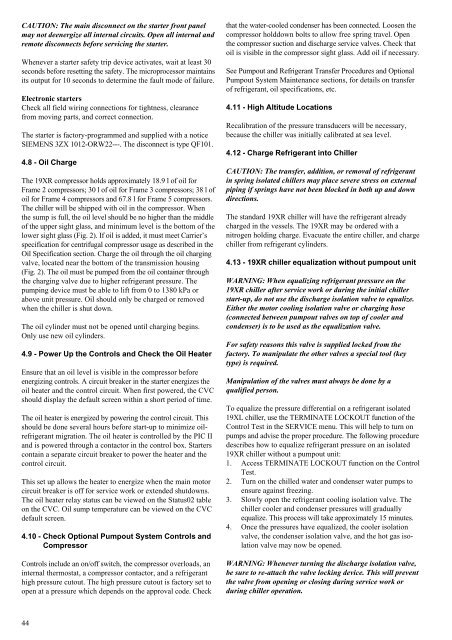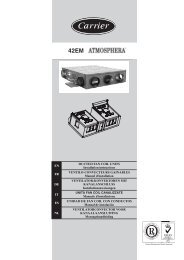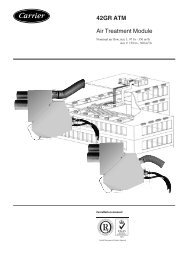19XR (PIC II) Hermetic Centrifugal Liquid Chillers 50 Hz - Carrier
19XR (PIC II) Hermetic Centrifugal Liquid Chillers 50 Hz - Carrier
19XR (PIC II) Hermetic Centrifugal Liquid Chillers 50 Hz - Carrier
You also want an ePaper? Increase the reach of your titles
YUMPU automatically turns print PDFs into web optimized ePapers that Google loves.
CAUTION: The main disconnect on the starter front panel<br />
may not deenergize all internal circuits. Open all internal and<br />
remote disconnects before servicing the starter.<br />
Whenever a starter safety trip device activates, wait at least 30<br />
seconds before resetting the safety. The microprocessor maintains<br />
its output for 10 seconds to determine the fault mode of failure.<br />
Electronic starters<br />
Check all field wiring connections for tightness, clearance<br />
from moving parts, and correct connection.<br />
The starter is factory-programmed and supplied with a notice<br />
SIEMENS 3ZX 1012-ORW22---. The disconnect is type QF101.<br />
4.8 - Oil Charge<br />
The <strong>19XR</strong> compressor holds approximately 18.9 l of oil for<br />
Frame 2 compressors; 30 l of oil for Frame 3 compressors; 38 l of<br />
oil for Frame 4 compressors and 67.8 l for Frame 5 compressors.<br />
The chiller will be shipped with oil in the compressor. When<br />
the sump is full, the oil level should be no higher than the middle<br />
of the upper sight glass, and minimum level is the bottom of the<br />
lower sight glass (Fig. 2). If oil is added, it must meet <strong>Carrier</strong>’s<br />
specification for centrifugal compressor usage as described in the<br />
Oil Specification section. Charge the oil through the oil charging<br />
valve, located near the bottom of the transmission housing<br />
(Fig. 2). The oil must be pumped from the oil container through<br />
the charging valve due to higher refrigerant pressure. The<br />
pumping device must be able to lift from 0 to 1380 kPa or<br />
above unit pressure. Oil should only be charged or removed<br />
when the chiller is shut down.<br />
The oil cylinder must not be opened until charging begins.<br />
Only use new oil cylinders.<br />
4.9 - Power Up the Controls and Check the Oil Heater<br />
Ensure that an oil level is visible in the compressor before<br />
energizing controls. A circuit breaker in the starter energizes the<br />
oil heater and the control circuit. When first powered, the CVC<br />
should display the default screen within a short period of time.<br />
The oil heater is energized by powering the control circuit. This<br />
should be done several hours before start-up to minimize oilrefrigerant<br />
migration. The oil heater is controlled by the <strong>PIC</strong> <strong>II</strong><br />
and is powered through a contactor in the control box. Starters<br />
contain a separate circuit breaker to power the heater and the<br />
control circuit.<br />
This set up allows the heater to energize when the main motor<br />
circuit breaker is off for service work or extended shutdowns.<br />
The oil heater relay status can be viewed on the Status02 table<br />
on the CVC. Oil sump temperature can be viewed on the CVC<br />
default screen.<br />
4.10 - Check Optional Pumpout System Controls and<br />
Compressor<br />
Controls include an on/off switch, the compressor overloads, an<br />
internal thermostat, a compressor contactor, and a refrigerant<br />
high pressure cutout. The high pressure cutout is factory set to<br />
open at a pressure which depends on the approval code. Check<br />
44<br />
that the water-cooled condenser has been connected. Loosen the<br />
compressor holddown bolts to allow free spring travel. Open<br />
the compressor suction and discharge service valves. Check that<br />
oil is visible in the compressor sight glass. Add oil if necessary.<br />
See Pumpout and Refrigerant Transfer Procedures and Optional<br />
Pumpout System Maintenance sections, for details on transfer<br />
of refrigerant, oil specifications, etc.<br />
4.11 - High Altitude Locations<br />
Recalibration of the pressure transducers will be necessary,<br />
because the chiller was initially calibrated at sea level.<br />
4.12 - Charge Refrigerant into Chiller<br />
CAUTION: The transfer, addition, or removal of refrigerant<br />
in spring isolated chillers may place severe stress on external<br />
piping if springs have not been blocked in both up and down<br />
directions.<br />
The standard <strong>19XR</strong> chiller will have the refrigerant already<br />
charged in the vessels. The <strong>19XR</strong> may be ordered with a<br />
nitrogen holding charge. Evacuate the entire chiller, and charge<br />
chiller from refrigerant cylinders.<br />
4.13 - <strong>19XR</strong> chiller equalization without pumpout unit<br />
WARNING: When equalizing refrigerant pressure on the<br />
<strong>19XR</strong> chiller after service work or during the initial chiller<br />
start-up, do not use the discharge isolation valve to equalize.<br />
Either the motor cooling isolation valve or charging hose<br />
(connected between pumpout valves on top of cooler and<br />
condenser) is to be used as the equalization valve.<br />
For safety reasons this valve is supplied locked from the<br />
factory. To manipulate the other valves a special tool (key<br />
type) is required.<br />
Manipulation of the valves must always be done by a<br />
qualified person.<br />
To equalize the pressure differential on a refrigerant isolated<br />
19XL chiller, use the TERMINATE LOCKOUT function of the<br />
Control Test in the SERVICE menu. This will help to turn on<br />
pumps and advise the proper procedure. The following procedure<br />
describes how to equalize refrigerant pressure on an isolated<br />
<strong>19XR</strong> chiller without a pumpout unit:<br />
1. Access TERMINATE LOCKOUT function on the Control<br />
Test.<br />
2. Turn on the chilled water and condenser water pumps to<br />
ensure against freezing.<br />
3. Slowly open the refrigerant cooling isolation valve. The<br />
chiller cooler and condenser pressures will gradually<br />
equalize. This process will take approximately 15 minutes.<br />
4. Once the pressures have equalized, the cooler isolation<br />
valve, the condenser isolation valve, and the hot gas isolation<br />
valve may now be opened.<br />
WARNING: Whenever turning the discharge isolation valve,<br />
be sure to re-attach the valve locking device. This will prevent<br />
the valve from opening or closing during service work or<br />
during chiller operation.




